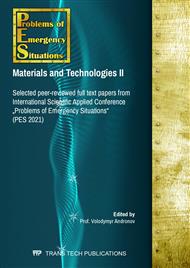p.251
p.258
p.266
p.276
p.282
p.290
p.296
p.303
p.317
Utilization of Galvanic Enterprises Sewage
Abstract:
A method for obtaining refractories based on inorganic glue as a reaction product of sludge from electroplating shops with sulfuric and phosphoric acids, which was tested by the authors in laboratory and industrial conditions in the article, is presents. After drying at a certain temperature, the manufactured samples are tested for strength. Properties of refractories based on inorganic glue are characterized by increased water resistance due to treatment with a cement solution. Based on experimental studies, the authors are presents the results of testing samples for strength with dry and wet aluminum-oxide abrasive. According to the test results, it was found that the specific density of the obtained samples increased from 0,57 to 0,9 g/cm3 with increasing glue content, while the strength decreased. Compositions with a low glue content had for the most strength.
Info:
Periodical:
Pages:
282-289
Citation:
Online since:
July 2021
Authors:
Price:
Сopyright:
© 2021 Trans Tech Publications Ltd. All Rights Reserved
Share:
Citation:


